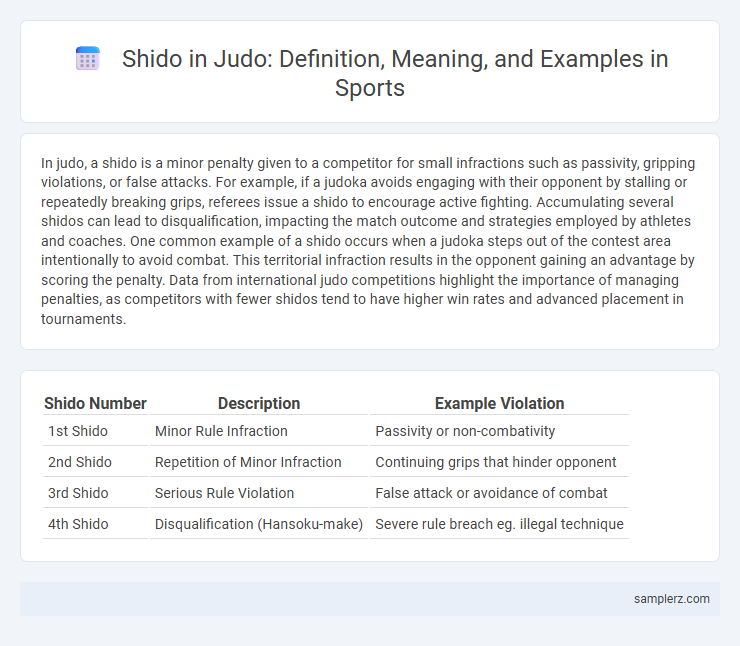In judo, a shido is a minor penalty given to a competitor for small infractions such as passivity, gripping violations, or false attacks. For example, if a judoka avoids engaging with their opponent by stalling or repeatedly breaking grips, referees issue a shido to encourage active fighting. Accumulating several shidos can lead to disqualification, impacting the match outcome and strategies employed by athletes and coaches. One common example of a shido occurs when a judoka steps out of the contest area intentionally to avoid combat. This territorial infraction results in the opponent gaining an advantage by scoring the penalty. Data from international judo competitions highlight the importance of managing penalties, as competitors with fewer shidos tend to have higher win rates and advanced placement in tournaments.
Table of Comparison
| Shido Number | Description | Example Violation |
|---|---|---|
| 1st Shido | Minor Rule Infraction | Passivity or non-combativity |
| 2nd Shido | Repetition of Minor Infraction | Continuing grips that hinder opponent |
| 3rd Shido | Serious Rule Violation | False attack or avoidance of combat |
| 4th Shido | Disqualification (Hansoku-make) | Severe rule breach eg. illegal technique |
Common Situations Leading to Shido in Judo
Common situations leading to shido in judo include defensive posture without attempting attack, gripping infringements such as holding the opponent's sleeve or lapel improperly, and stepping out of the contest area during active fighting. Referee warnings for passivity or false attacks are frequent when a competitor avoids engagement or uses tactics solely to stall the match. Understanding these scenarios helps judokas avoid penalties and maintain competitive advantage during matches.
Shido for Gripping Infractions: Examples
Shido for gripping infractions in judo occurs when a competitor violates the rules regarding grip control, such as holding the opponent's sleeve or collar improperly or using an illegal grip that restricts movement. Examples include maintaining a grip on the opponent's belt for more than five seconds or gripping inside the opponent's sleeve, which disrupts fair play and can lead to a shido penalty. These infractions are penalized to ensure dynamic and balanced judo matches, promoting technique over stalling tactics.
Shido Due to Passivity or Non-Combativity
Shido due to passivity or non-combativity in judo is a penalty given when a competitor fails to engage actively in the match, such as avoiding grips or attacks. This rule encourages continuous combat and rewards positive judo techniques. Accumulating multiple shidos for passivity can lead to hansoku-make, resulting in disqualification.
Illegal Defensive Postures Resulting in Shido
In judo, illegal defensive postures such as deliberately avoiding grips by turning away or excessively leaning back to prevent an opponent's attack result in a shido penalty. These actions disrupt the flow of the match and violate the sport's regulation of active engagement and fair play. Shido serves to encourage proper technique and maintain competitive integrity during bouts.
False Attack Techniques Penalized with Shido
False attack techniques in judo, such as feigned strikes or insincere grip attempts, result in a shido penalty to maintain fair play and match integrity. These deceptive moves, aimed at gaining an unfair advantage without genuine offensive intent, disrupt the flow of combat and are carefully monitored by referees. The enforcement of shido penalties for false attacks ensures adherence to judo's principle of effective and honest technique execution.
Shido for Leaving the Contest Area
A shido in judo is a penalty given for minor rule infringements, with one common example being leaving the contest area intentionally or repeatedly. Competitors who exit the tatami to avoid engagement or gain a tactical advantage receive a shido, which can impact match scoring by accumulating warnings. Referees closely monitor area boundaries to enforce this rule and maintain fairness during bouts.
Unsportsmanlike Behavior and Shido Instances
Shido penalties in judo often arise from unsportsmanlike behaviors such as gripping violations, false attacks, or passivity, each reflecting breaches of competitive fairness. Notably, persistent avoidance of combat or intentional stalling to gain tactical advantage typically results in accumulating shido warnings leading to disqualification. Top-level tournaments like the Olympics and World Championships frequently showcase these shido instances, emphasizing rule adherence to maintain the sport's integrity.
Breaking the Grip Without Immediate Attack: Shido Cases
In judo, receiving a shido for breaking the grip without launching an immediate attack often occurs when a competitor disrupts the opponent's hold but fails to capitalize by initiating a timely offensive move, which is considered passivity or non-combativity. This penalty enforces the rule that grip breaking must be accompanied by an active attempt to engage, promoting continuous combat and technical skill. Notable cases include matches where athletes strategically neutralize grips yet hesitate to attack, resulting in shido penalties that influence match outcomes and scoring dynamics.
Shido Issued for Dangerous Throws or Actions
In judo, a shido can be issued for dangerous throws such as executing an ippon seoi-nage with excessive force or improper technique that risks injury to the opponent. Referees closely monitor behavior like grabbing the opponent's gi too aggressively or applying throws that could cause head or neck trauma. Penalizing these dangerous actions ensures athlete safety and maintains fair competition standards.
Frequent Shido Examples in International Judo Matches
Frequent shido penalties in international judo matches often include grip fighting violations such as failing to attack or hold a grip for too long without engaging, stepping outside the contest area, and passivity by avoiding combat or defensive posture. Judokas may also receive shido for false attacks that do not attempt a real throw or using prohibited techniques like leg grabs under current IJF rules. Understanding these common shido scenarios is crucial for athletes seeking to compete effectively at the global level.

example of shido in judo Infographic
 samplerz.com
samplerz.com